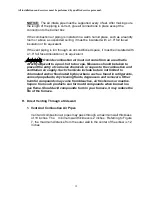
All installations and services must be performed by qualified service personnel.
8
accordance with the latest edition of the UL Standard for Single and Multiple Station
Carbon Monoxide Alarms, UL 2034, or the CSA International Standard, Residential
Carbon Monoxide Alarming Devises, CSA 6.19.
5. The installer shall be familiar with and comply with all codes and regulations
applicable to the installation of these heating appliances and related equipment. In
lieu of local codes, the installation shall be in accordance with the current provisions
of one or more of the following standards.
a. Federal Manufactured Home Constructions & Safety Standard (H.U.D. Total
24, Part 280.)
b. American National Standard (ANSI-119.2/NFPA-501C) for all recreational
vehicle installations.
c. American National Standard (ANSI-Z223.1/NFPA-54) for all gas-fired
furnaces.
d. American National Standard (ANSI-C1/NFPA-70 Electric Code for all
electrical field wiring.
e. These gas-fired units have been investigated under standards ANSI Z 21.47
CAN/CGA Z223-2001 Central Furnace test standards.
f. These gas-fired units have been listed by ETL “For installation as central
furnace special type for single story dwelling.”
: The area around the furnace must be kept free and clear of
combustible materials, especially papers and rags.
: This furnace is not to be used as a construction heater.
Listed below are definitions of “ COMBUSTIBLE MATERIAL” and “NON-
COMBUSTIBLE MATERIAL.”
COMBUSTIBLE MATERIAL:
Material made of or surfaced with wood, compressed paper, plant fibers, plastics or
other material that will ignite.
NON-COMBUSTIBLE MATERIAL:
Material that will not ignite and burn. Such materials consist entirely of steel, iron, brick,
tile, concrete, slate, glass or a plaster combination thereof.












































